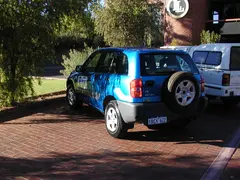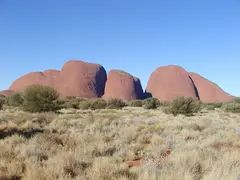 Drove the long drive from Alice Springs to Yulara taking in the
Henbury meter right craters (which have given rise to green
oases in scrub desert). The scrubland is not all the same unlike
the Daintree which is like a goulash of trees. At times in the
Red Centre poplar like trees dominate so it looks like a crowd
of people turned to word sometimes part shaped sometimes low
bushes. Much burning – a cloud of smoke overhung
Uluru – I’m
still jaded but the rock seemed to glow, seemed to be plastic
not really there. The
Olgas were even more fantastic. The hotel
is a little washout – no telephone (socket so I could have use
the laptop) or TV.
Nota Bona the trees were
one tree – the Desert Oak has a single trunk while it is young
but when it finds water with its roots it matures assumes an oak
design.
Drove the long drive from Alice Springs to Yulara taking in the
Henbury meter right craters (which have given rise to green
oases in scrub desert). The scrubland is not all the same unlike
the Daintree which is like a goulash of trees. At times in the
Red Centre poplar like trees dominate so it looks like a crowd
of people turned to word sometimes part shaped sometimes low
bushes. Much burning – a cloud of smoke overhung
Uluru – I’m
still jaded but the rock seemed to glow, seemed to be plastic
not really there. The
Olgas were even more fantastic. The hotel
is a little washout – no telephone (socket so I could have use
the laptop) or TV.
Nota Bona the trees were
one tree – the Desert Oak has a single trunk while it is young
but when it finds water with its roots it matures assumes an oak
design.
It is cold here as soon as the sun dips down – needed my jacket for tonight’s star gazing at Yulara. The stars seem much brighter here. The star gazing was educational – I now can find the Southern Cross with Alpha Centauri and Beta Centauri pointing at it (Alpha is first brightest star in a constellation Beta next et cetera) Alpha Centauri is in fact three stars. M6 looks uncannily like a butterfly.
The Red Centre lives up to its name by the way. It is very red. A scrub desert with red sand. Vast distances to cover on roads with no speed limit and seemingly no other cars. Suddenly you might sight a wild camel or lone dingo by the side of the road, right by the side of the road. And then you’re past it, glad you didn’t add to the numbers killed.
 Day started rather early with watching sun rise over Uluru, then
breakfast at the Ananga cultural centre (they have leased Uluru
and
Kata Tjuta
to the Australian Park service for 99 years).
Weakened and got mum an Ayer’s Rock jigsaw later on today. After
breakfast two aboriginal guides and a female interpreter led us
on a journey into their world – they made kiti glue from
Spinifex grass (founded to get the sack which was welded in to a
black ball of kiti which could be used later by warming it up –
they said Kiti can be used for many things like radiators tyres
balls spear shafts et cetera plastics good). The bowls are
hollowed out tree sections – some of us had a go at spear
chucking or posing with a ring then a bowl on head (women only).
Day started rather early with watching sun rise over Uluru, then
breakfast at the Ananga cultural centre (they have leased Uluru
and
Kata Tjuta
to the Australian Park service for 99 years).
Weakened and got mum an Ayer’s Rock jigsaw later on today. After
breakfast two aboriginal guides and a female interpreter led us
on a journey into their world – they made kiti glue from
Spinifex grass (founded to get the sack which was welded in to a
black ball of kiti which could be used later by warming it up –
they said Kiti can be used for many things like radiators tyres
balls spear shafts et cetera plastics good). The bowls are
hollowed out tree sections – some of us had a go at spear
chucking or posing with a ring then a bowl on head (women only).
The natives here wove human hair into belts from which they could suspend staff round their waists – they also stuck staff in their hair. One of the two guides told us the story of the blue tongued lizard and the bower bird (told differently in the cultural centre). (Lizard steals emu’s meat from bird and gets burnt to death). Did some washing then had a look at Kata Tjuta (the Olgas). Impressive but light not right – started Valley of the Windswalk but gave up as a fly was bothering me – tried a sunset picture of Uluru from the sunrise point but not worth it – at least one picture worked today (of some Bauhinia the natives used as a sugar substitute). Had an expensive supper with a glass of wine which has made me tipsy – I confess very cold at nights in the red centre and they’re half an hour out (only place I’ve found like this).
Uluru is the big tourist attraction here (Uluru being the Aboriginal name for Ayer’s Rock.) I didn’t climb it by the way. The Aborigines prefer that you don’t, and the climb is strenuous and exposed. I was disappointed by Uluru. Disappointed by this symbol of Australia which people almost worship at sunset and sunrise. Perhaps it was expecting too much. Perhaps it was that experiences need to be shared. Life needs to be shared.
Every hole and cleft in Uluru is part of Aboriginal lore.
 I preferred Kata Tjuta (or many heads) as an enigmatic group
of rocks to Uluru. Kata Tjuta is what is also called the Olgas.
There are many different Aborigine groups and languages and
names for things like kangaroos vary. The dreamtime stories of
the Aborigines bind together their history, the geography, the
lore of plants and animals, the way they live. For them (if I
understand correctly) life is an integrated whole in which the
parts reinforce each other. They find identity as part of the
whole not as individuals.
I preferred Kata Tjuta (or many heads) as an enigmatic group
of rocks to Uluru. Kata Tjuta is what is also called the Olgas.
There are many different Aborigine groups and languages and
names for things like kangaroos vary. The dreamtime stories of
the Aborigines bind together their history, the geography, the
lore of plants and animals, the way they live. For them (if I
understand correctly) life is an integrated whole in which the
parts reinforce each other. They find identity as part of the
whole not as individuals.